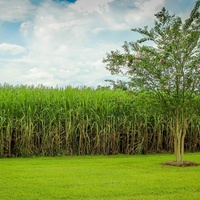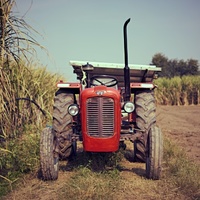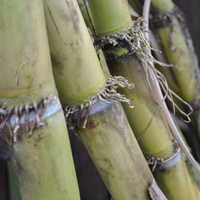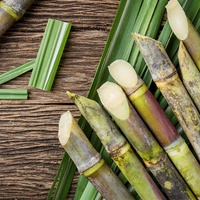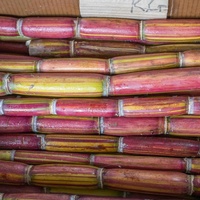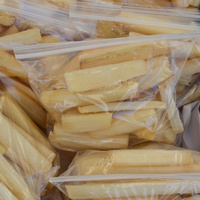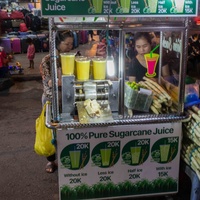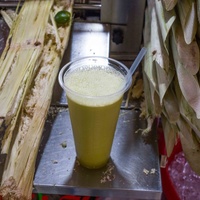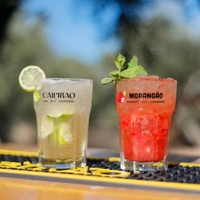Common name: Sugarcane
Other common names: Noble cane
Description
Sugarcane is a tall grass originating from the Old World tropics, most probably highland areas of Papua New Guinea and is the primary source of the world's sugar, made from the sweet juice or sap in its stems. Its use, however, extends far beyond sugar production, with various parts of the plant used as raw material in a range of industries, including energy, chemicals, natural fibres and livestock feed.
Closely related to bamboo and other grasses, sugarcane has erect stems typically 3 to 5 m (10 to 16 ft) tall and 3 to 7 cm (1.2 to 2.7 in) in diameter, made of jointed sections 20 to 40 cm (0.6 to 1.3 ft) long. These grow in clumps sprouting from underground rhizomes.
Between the joints is a smooth, hard exterior that protects a semi-soft, fibrous and juicy core. Known as the rind or peel, it has a waxy coating and can range in colour from lime green, through yellow or purple to nearly black, or it may be variegated, depending on the variety. Also varying with variety are the stem diameter, rind thickness, amount of juice and juice sweetness.
The leaves are long, medium-green and sword-shaped, with sharp, serrated edges that slice into fingers. These sprout from new growth at the top of the stems and have an upright habit that adds to the height of the plant, in the end, making up almost one-third of the plant's height in total.
Flowering occurs when the plant reaches maturity and is encouraged by short days or rather long nights. Tall flower spikes arise at the top of the plant and hold aloft a large, triangular-shaped flower-head, which is known as the arrow because of its shape. Although sugarcane flowers profusely, the flowers rarely set seed.
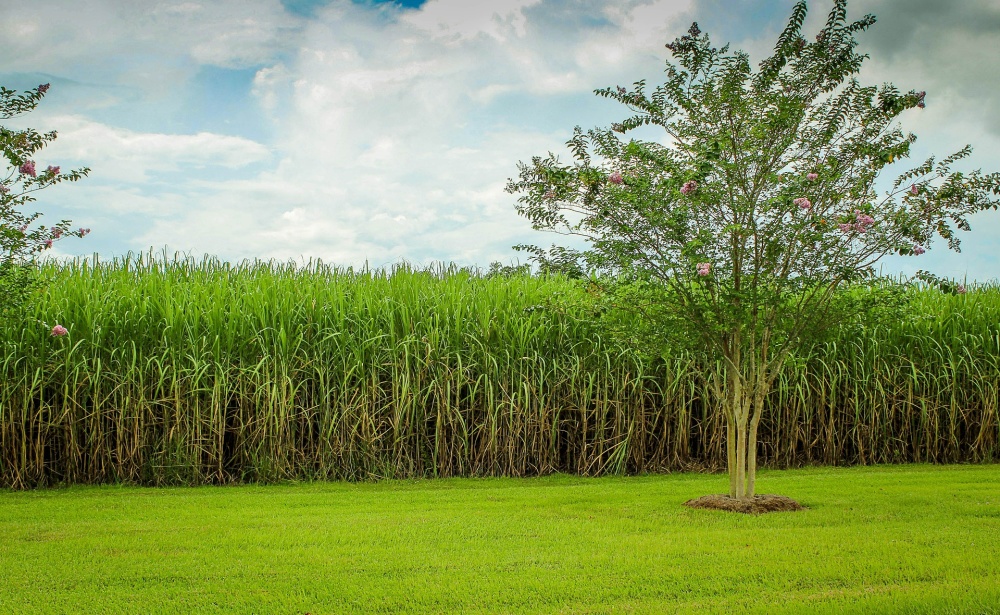
Photo by JamesDeMers from Pixabay
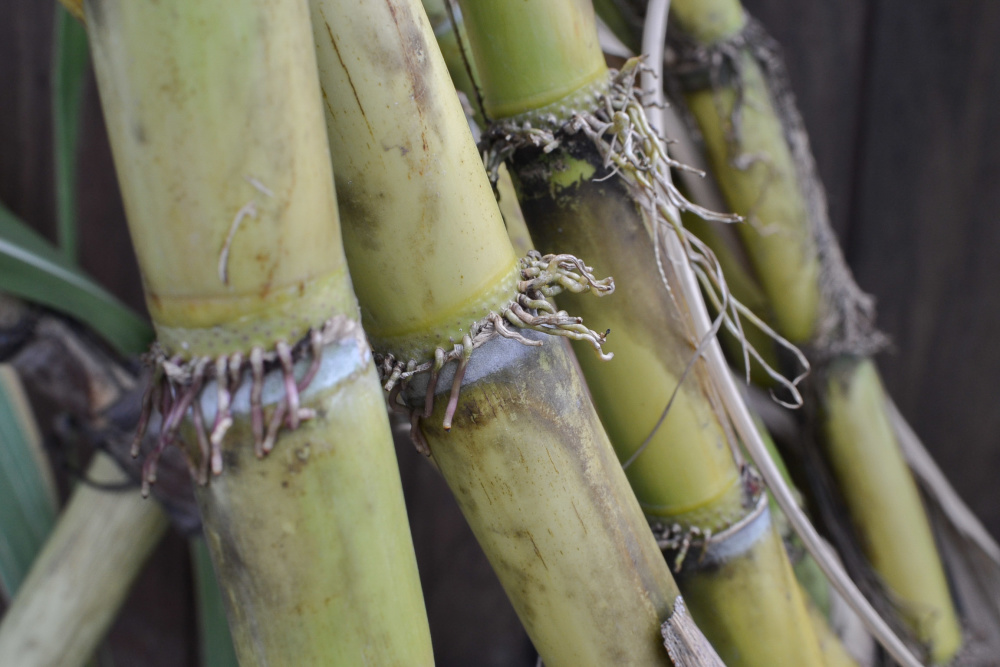
Use
According to its use, sugarcane can be separated into two main types: chewing canes and crystal canes, or types used in sugar production. Chewing cane, which, as the name suggests, is chewed, is the original use for sugarcane, with its cultivation dating back hundreds of years. Although still cultivated today, it is grown mostly in home gardens for personal use.
Chewing canes are thick-stemmed canes with a relatively soft core and high juice and sugar content. The mature stems are usually cut into manageable lengths, the rind peeled, sometimes with the teeth, and the soft, fibrous core chewed and sucked to extract the juice, then spat out. Sometimes the peeled lengths are cut into bite-sized pieces, bagged and sold at the market or roadside.
Chewing canes are also cut into swizzle sticks to dress up fancy drinks and tropical cocktails served at bars and holiday resorts.
Crystal canes, or canes used in sugar production, tend to be slimmer-stemmed canes and have juice with a higher sucrose content, causing it to crystallize readily.
Sugarcane is made by cutting the stems into shorter lengths and pressing them to extract the juice. The extracted juice is then filtered and boiled to evaporate the water, leaving behind a syrup that, when crystallised, makes raw sugar. However, raw sugar contains molasses, a thick, dark, almost black syrup that, despite a high sugar content, cannot be crystallised. So it needs to be removed, leaving behind refined white sugar. Refined brown sugar is made by adding back some of the molasses to the white sugar. Castor sugar and icing (or powdered) sugar is simply finely ground white sugar.
Refined sugar is the world's most widely available and consumed sweetener. It is incorporated in many foods and drinks, making it a globally important energy food. In jams, jellies, fruit conserves, canned fruit and confectionery, it is used as both a sweetener and preservative.
A by-product of the refined sugar-making process is molasses. Molasses is arguably the most nutritious component of sugarcane juice, containing reasonable amounts of potassium, calcium, magnesium, selenium, iron, and Vitamin B6. Refined sugar, by contrast, is almost pure sucrose, with a high energy value but little or no nutritional value.
Most molasses is converted into ethyl alcohol, otherwise known as ethanol. It is fermented with yeast and water to make a solution known as the 'Wash', containing up to nine per cent alcohol. The wash is then distilled to extract the alcohol, traditionally in pot stills but in more recent times in sophisticated continuous column stills.
Ethanol produced from sugarcane was initially intended only to make rum for drinking. But other uses soon followed, including use as a solvent and carrier in perfumes and colognes, such as in Bay Rum, made by mixing rum with bay oil from the leaves of the Bay Rum tree (Pimenta racemosa). Ethanol has become widely used as an industrial solvent due to its ability to dissolve organic materials such as gums, resins and essential oils.
More recently, ethanol has been used as a fuel for internal combustion engines and is produced on a massive scale in Brazil and the United States for this purpose. It has also emerged as a material to substitute for petroleum in making plastic.
It takes 2 to 3 litres (0.5 to 0.8 gallons) of molasses to make 1 litre (0.3 gallons) of rum. When freshly distilled, rum is a colourless liquid of around 50 per cent overproof, which means it takes 100 litres of it to produce 150 litres of regular rum after diluting with water. Dark rum gets its caramel colour from the oak barrels in which it is aged, which on average is five years but can be up to twenty years or more for some premium-aged rums. Ethanol from molasses is also used to make gin and vodka.
A small proportion of molasses, particularly of the lighter grades, is reserved for human consumption. Traditionally sold in jugs and jars, it has long been used in baking to make sweet buns and Christmas puddings. It is also used in candy confectionery and barbecue sauces, and it is what gives Boston Baked Beans its characteristic sweetness and syrupy texture.
Molasses is also an important livestock feed, particularly during the dry season when there is little else for ruminant livestock to eat. It is usually mixed with chopped-up cane tops and leaves or is poured over silage, hay or grains fed to cows, sheep and goats. It is also added to pig and chicken rations. Apart from being a good carbohydrate, molasses is highly palatable, increasing livestock acceptance of the other feeds mixed with it.
In traditional sugar production, the molasses is not removed, and the crystallisation and refining processes are skipped, resulting in a dark brown, semi-moist but highly nutritious sugar. Known as 'Jaggery' or 'Gur' in India and 'Panela' in Latin America, it is usually moulded into shapes for easy transport, sale and storage. However, its relatively high moisture content has a shorter shelf-life than refined sugar.
A less conventional use of molasses is rust removal. Powerful chelating agents in the molasses, mainly cyclic hydroxamic acid, actively bind with rust and make it soluble. It is then washed off with water. However, rust-covered items need to be fully immersed in molasses for at least three months for the treatment to be effective.
Sometimes cane juice is not processed into sugar but directly fermented and distilled, as is the case with Cachaça, a distilled spirit from Brazil. Cachaça is best known for its role in the Caipirinha, a Brazilian cocktail made by blending shots of Cachaça with slices of lime, sugar and crushed ice. A similar spirit, known as Rhum Agricole, comes from the Caribbean island of Martinique. Sugarcane juice is also commonly enjoyed without alcohol, usually chilled and with a squeeze of lime added to balance its sweetness.
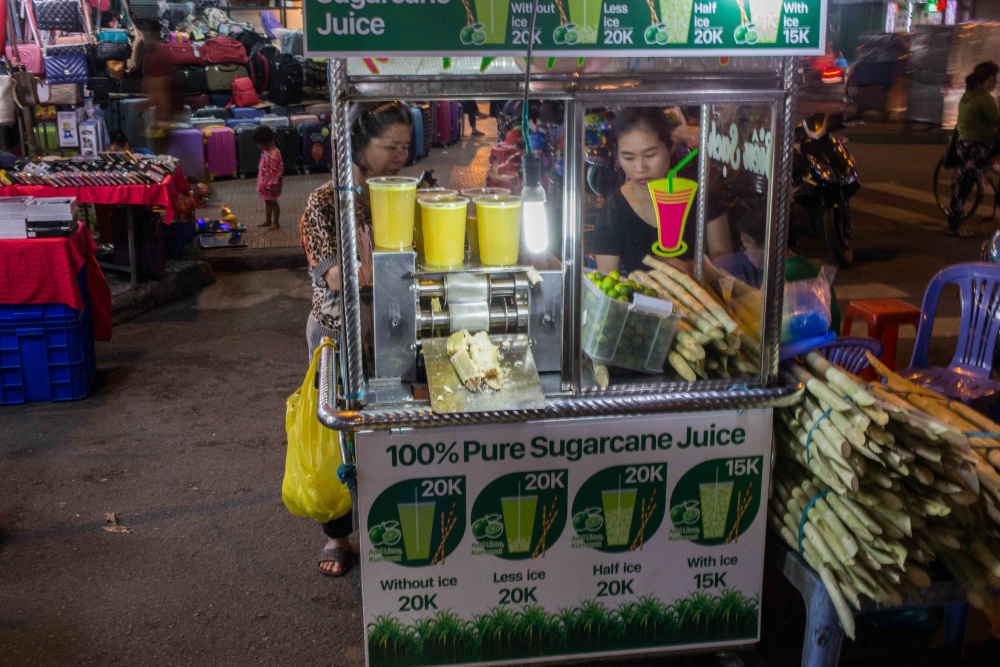
Sugarcane juice vendor (Vietnam)
After extracting the juice from the stems, large amounts of a fibrous material remain, known as bagasse or megass. It is usually burnt in giant boilers at the sugar factory to produce heat, steam and electricity to power the factory and with any excess electricity exported to the grid. If not burnt as fuel, bagasse can be compressed and moulded into biodegradable products. Bagasse derived products include fibreboard (for wallboards, panelling and acoustic tiles) and food-service or packaging products, such as disposable plates, cups and take-away food containers.
Bagasse is also commonly baled and sold as a mulch under the name 'Sugar Cane Mulch'. Inexpensive, lightweight and easy to handle, sugarcane mulch works much like other mulches to conserve soil moisture, reduce soil erosion and suppress weeds. And because it breaks down quickly, it improves the soil, making it ideal for vegetable gardens.
Although bagasse is generally a poor fibre for paper pulp production due to damage sustained during juice extraction, it is sufficient for making newsprint and wrapping paper.
A hard, tan-coloured wax - similar to carnauba wax from the Wax palm (Copernicia prunifera) - is sometimes recovered from the residue and formulated into waxes for floors, furniture, leather and waxed paper. A ton of sugarcane yields from 1 to 1.4 kilograms (2 to 3 lbs) of wax.
Health use
Molasses is rich in calcium and iron, which helps promote good bone and tissue health.
Climate
Sugarcane grows naturally in humid subtropical and tropical and climates, generally areas with annual lows of 12 to 25°C, annual highs of 22 to 36°C, annual rainfall of 1200 to 5000 mm and a dry season of 4 months or less.
Sugarcane is also cultivated with irrigation in much drier areas, such as in El Centro, California and the Nile Delta in Egypt. These areas receive less than 100 mm of rainfall annually and are classed as arid or dry all 12 months of the year.
General interest
Not widely known is that for almost a thousand years, sugarcane was cultivated along the Mediterranean coast. Cultivation mostly ceased after colonial powers established sugar plantations in the Caribbean and other parts of the Americas. Today, ruins of sugarcane mills still standing in Motril, Spain, Syracuse, Sicily, Palestine, and the deserts of southern Morocco are there to remind us of that era. Although sugarcane continued to be cultivated in Valencia, Spain in the eighteenth century, it was not converted into sugar but chewed as a refreshment.
Growing
New plants are usually started from cuttings, called 'setts' or 'billets', comprising one to three jointed sections taken from mature canes.
These are planted horizontally or at a 45° degree angle in the soil, leaving one end about 5 cm (2 in) above the soil. Good practice is to grow the crop on soil mounds or ridges so that the roots have enough room to grow down and there is adequate drainage. The conventional method of planting in furrows increases the risk of waterlogging and subsequently rot.
Soil preparation and planting are carried out near the end of the rainy season when there is sufficient soil moisture for good growth and development.
Performs best on deep, rich, friable and free-draining clay-loam, loam and sandy-loam soils of a moderately acid to slightly alkaline nature, generally with a pH of 6.0 to 7.7, and on sites with full sun exposure.
Problem features
The leaves have sharp edges that can cause injury. There are also fine hairs on the leaf-sheath that can irritate the skin.
Where it grows
References
Books
-
Adams, C. D. 1972, Flowering plants of Jamaica, University of the West Indies, Mona, Greater Kingston
-
Bladholm, L. 1999, The Asian grocery store demystified, 1st edition, Renaissance Books, Los Angeles, California
-
Brady, G. S. & Clauser, H. R & Vaccari, J. A. 2002, Materials handbook : an encyclopedia for managers, technical professionals, purchasing and production managers, technicians and supervisors, 15th ed., McGraw-Hill, New York
-
Crane, E., Walker, P. & Day, R. 1984, Directory of important world honey sources, International Bee Research Association, London
-
Gohl, B. 1981, Tropical Feeds : feed information summaries and nutritive values (Revised edition), Food and Agriculture Organization of the United Nations (FAO), Rome
-
Macmillan, H. F. 1943, Tropical planting and gardening : with special reference to Ceylon, 5th ed, Macmillan Publishing, London
-
McIlroy, R.J. 1963, An introduction to tropical cash crops, Ibadan University Press, Ibadan, Nigeria
-
Mors, W. B & Rizzini, C. T. 1966, Useful plants of Brazil, Holden-Day Publishing, San Francisco, California
-
Parkinson, R. 1999, Culinaria : The Caribbean a culinary discovery, 1st. ed, Koìln: koìnemann, Germany
-
Purseglove, J. W. 1981, Tropical crops: Monocotyledons, Longman, Harlow, London
-
Randall, R. P. 2002, A global compendium of weeds, R.G. and F.J. Richardson Press, Melbourne
-
Randall, R. P. 2007, The introduced flora of Australia and its weed status, Cooperative Research Centre for Australian Weed Management, Glen Osmond, South Australia
-
Stewart, A. 2013, The drunken botanist : the plants that create the world's great drinks, 1st ed., Algonquin Books, Chapel Hill, North Carolina
-
Wood, I. M. 1997, Fibre crops : new opportunities for Australian agriculture, Queensland Department of Primary Industries (QLD DPI), Brisbane
Articles, Journals, Reports and Working Papers
-
Morton, J. F. 1976, Pestiferous spread of many ornamental and fruit species in south Florida. In Proceedings of the Florida State Horticultural Society (Vol. 89, pp. 348-353).
-
Morton, J.F. 1964, Honeybee Plants of South Florida, Proceedings of the Florida State Horticultural Society, Vol 77:415-436.
